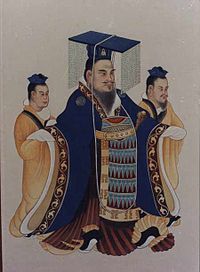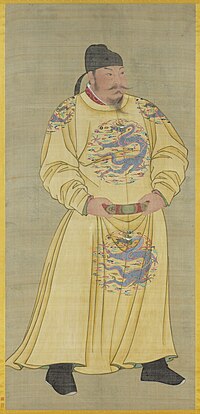-
Use Cases
-
Resources
-
Pricing
Spring and Autumn Period
Battle of Bi
722 BC
% complete
The Battle of Bi in 722 BC was a significant conflict between the states of Chu and Jin during the Spring and Autumn Period. It marked a turning point in the power dynamics of the region and contributed to the eventual emergence of the Warring States Period.
Image source: Battle of Bi

Warring States Period
Construction of the Great Wall
700 BC - 699 BC
% complete
The construction of the Great Wall of China began during the Warring States Period as various states built defensive walls to protect their territories. This marked the early stages of what would later become the iconic structure known as the Great Wall.
Image source: Great Wall of China

Battle of Maling
341 BC
% complete
The Battle of Maling in 341 BC was a decisive victory for the state of Qin over the state of Chu during the Warring States Period. It demonstrated the military prowess of Qin and significantly altered the balance of power among the warring states.
Image source: Battle of Maling

Han Dynasty
Founding of the Han Dynasty
202 BC
% complete
The founding of the Han Dynasty in 202 BC marked the beginning of a golden age in Chinese history. Under the leadership of Emperor Gaozu, the Han Dynasty brought stability, prosperity, and cultural advancements to the region.
Image source: Han dynasty

Silk Road Trade Flourishes
200 BC - 199 BC
% complete
During the Han Dynasty, the Silk Road trade routes experienced significant growth and prosperity, facilitating the exchange of goods, technologies, and cultural influences between China and the civilizations of Central Asia, the Middle East, and Europe.
Image source: Silk Road

Reforms of Emperor Wu of Han
141 BC
% complete
Emperor Wu of Han implemented a series of far-reaching reforms during his reign, including the establishment of Confucianism as the state ideology, the expansion of the empire through military campaigns, and the promotion of economic development and cultural exchange along the Silk Road.
Image source: Emperor Wu of Han

Confucian Revival under Emperor Wu of Han
136 BC
% complete
Emperor Wu of Han initiated a revival of Confucianism as the dominant ideology in the Han Dynasty, promoting the teachings of Confucius and emphasizing the importance of filial piety, social order, and ethical governance. This revival had a lasting impact on Chinese culture and governance.
Three Kingdoms Period
Battle of Guandu
200 AD
% complete
The Battle of Guandu in 200 AD was a pivotal confrontation between the warlords Cao Cao and Yuan Shao during the Three Kingdoms Period. Cao Cao's victory solidified his position and set the stage for the eventual unification of northern China under the Wei Dynasty.
Image source: Battle of Guandu

Battle of Red Cliffs
208 AD
% complete
The Battle of Red Cliffs in 208 AD was a pivotal naval engagement that resulted in the defeat of the combined forces of Cao Cao by the allied armies of Sun Quan and Liu Bei. This event played a crucial role in shaping the subsequent division of China into the Three Kingdoms.
Image source: Battle of Red Cliffs

Sui Dynasty
Establishment of the Sui Dynasty
581 AD
% complete
The establishment of the Sui Dynasty in 581 AD marked a period of reunification and centralized rule in China after centuries of division. The Sui Dynasty laid the groundwork for the subsequent flourishing of the Tang Dynasty.
Image source: Sui dynasty

Tang Dynasty
Reign of Emperor Taizong
626 AD - 649 AD
% complete
The reign of Emperor Taizong from 626 to 649 AD is often regarded as a pinnacle of the Tang Dynasty. Known for his military conquests, administrative reforms, and promotion of the arts and culture, Emperor Taizong's era is considered one of the golden ages of Chinese civilization.
Image source: Emperor Taizong of Tang

Reign of Emperor Xuanzong
712 AD - 756 AD
% complete
The reign of Emperor Xuanzong from 712 to 756 AD, known as the Kaiyuan era, was characterized by remarkable prosperity, cultural achievements, and diplomatic influence. It is often regarded as a high point in the Tang Dynasty's golden age.
Image source: Emperor Xuanzong of Tang

Battle of Talas
751 AD
% complete
The Battle of Talas in 751 AD was a pivotal conflict between the Abbasid Caliphate and the Tang Dynasty. It resulted in the capture of Chinese soldiers skilled in papermaking, leading to the transfer of this technology to the Islamic world and ultimately to Europe.
Image source: Battle of Talas

An Lushan Rebellion
755 AD - 763 AD
% complete
The An Lushan Rebellion, lasting from 755 to 763 AD, was a devastating internal conflict that severely weakened the Tang Dynasty and led to significant social and economic upheaval in China. The rebellion had long-term repercussions for the stability of the empire.
Image source: An Lushan rebellion

Invention of Woodblock Printing
868 AD
% complete
The invention of woodblock printing in 868 AD during the Tang Dynasty revolutionized the dissemination of knowledge and culture in China and beyond. This innovation laid the foundation for the development of printing technologies and the spread of literature and religious texts.
Image source: History of printing in East Asia

Key Facts
- The Tang Dynasty is known for its flourishing economy and cultural achievements, including poetry and calligraphy.
- The Grand Canal, a significant engineering feat, was completed during the Sui and Tang Dynasties, facilitating trade and transportation.
- The Song Dynasty was a period of innovation, with advancements in agriculture, industry, and technology, such as printing and gunpowder.
- During the Tang and Song Dynasties, China experienced a thriving Silk Road trade and cultural exchanges with foreign civilizations.
- The Golden Ages of China saw a peak in the production of art, ceramics, and literature, contributing to the country's rich cultural heritage.
Source
This China's Golden Ages timeline was generated with the help of AI using information found on the internet.
We strive to make these timelines as accurate as possible, but occasionally inaccurates slip in. If you notice anything amiss, let us know at [email protected] and we'll correct it for future visitors.
Create a timeline like this one for free
Preceden lets you create stunning timelines using AI or manually.
Customize your timeline with one of our low-cost paid plans
Export your timeline, add your own events, edit or remove AI-generated events, and much more
Free
$
0
free forever
No credit card required.
Basic
$
10
/month
billed annually
Cancel anytime.
Pro
$
16
/month
billed annually
Cancel anytime.
Common Questions
Can I cancel anytime?
Yes. You can cancel your subscription from your account page at anytime which will ensure you are not charged again. If you cancel you can still access your subscription for the full time period you paid for.
Will you send an annual renewal reminder?
Yes, we will email you a reminder prior to the annual renewal and will also email you a receipt.
Do you offer refunds?
Yes. You can email us within 15 days of any payment and we will issue you a full refund.
What if I have more questions?
Check out our pricing docs or send us an email anytime: [email protected].